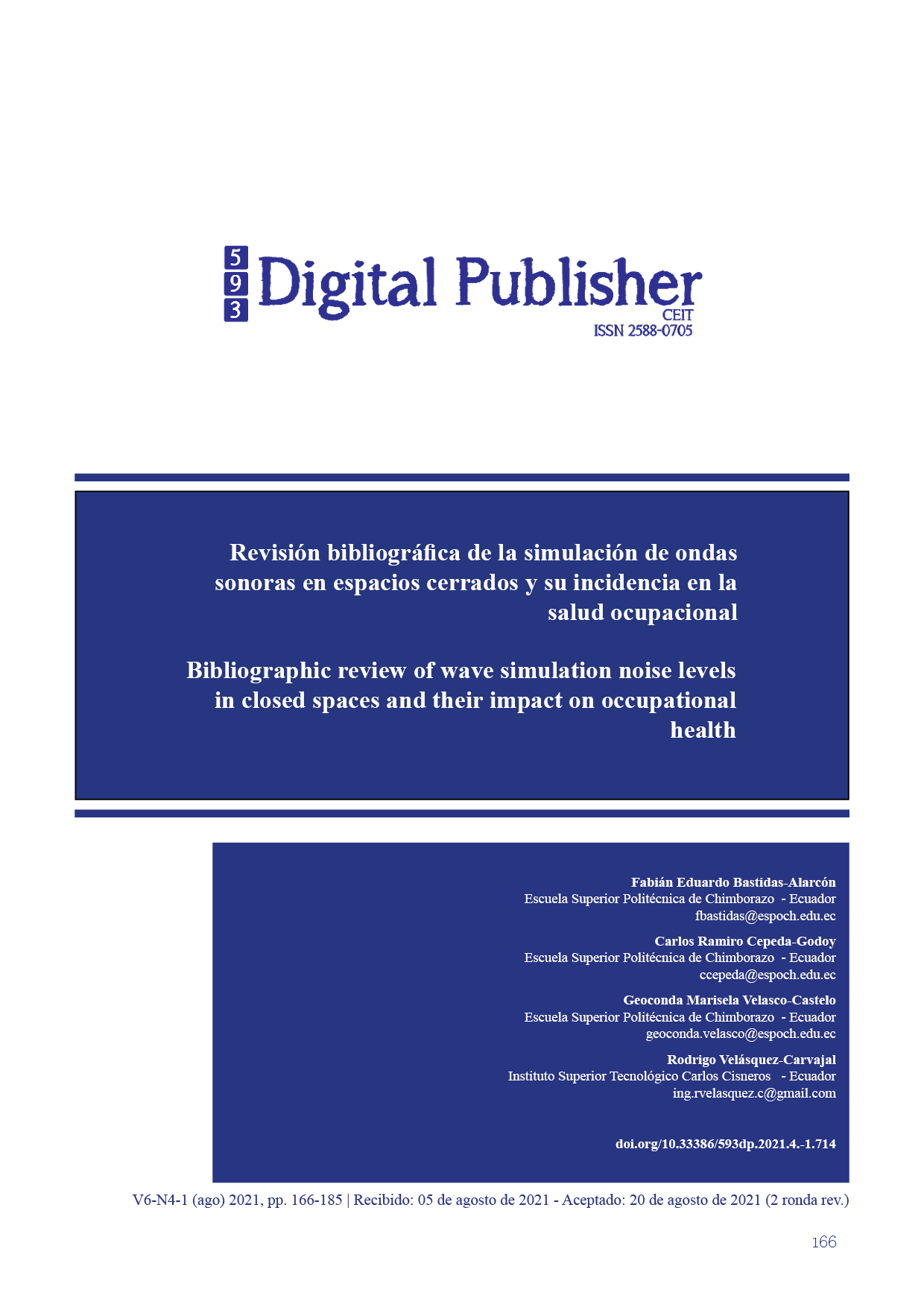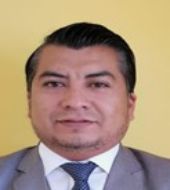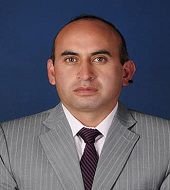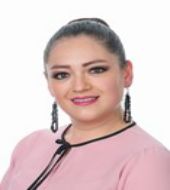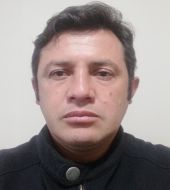Bibliographic Review of wave simulation noise levels in closed spaces and their impact on occupational health
Main Article Content
Abstract
Noise is ubiquitous in everyday life and can cause both hearing and non-hearing health effects. Loss of noise induced hearing is still very prevalent in environments occupational diseases and is increasingly caused by frequent exposure over the permissible limits of sound waves. This article introduces a review of the scope of the literature on wave simulation noise levels in closed spaces and the effects on occupational health. The methodology is based on four steps, which pose research questions, search for documents, selected papers and obtaining data. Out of a total of 316 database articles reviewed, such as Springer Link, Google Academic, Redalyc, Scopus and Scielo, 40 were finally elected. It was analyzed that the auditory and non-auditory effects by the presence of noise in closed places is increasing, showing that exposure causes discomfort and disturbs sleep, causing daytime sleepiness, which affects people’s performance, as well as increases the occurrence of hypertension, cardiovascular diseases and it could impair
Downloads
Article Details

This work is licensed under a Creative Commons Attribution-NonCommercial-ShareAlike 4.0 International License.
1. Derechos de autor
Las obras que se publican en 593 Digital Publisher CEIT están sujetas a los siguientes términos:
1.1. 593 Digital Publisher CEIT, conserva los derechos patrimoniales (copyright) de las obras publicadas, favorece y permite la reutilización de las mismas bajo la licencia Licencia Creative Commons 4.0 de Reconocimiento-NoComercial-CompartirIgual 4.0, por lo cual se pueden copiar, usar, difundir, transmitir y exponer públicamente, siempre que:
1.1.a. Se cite la autoría y fuente original de su publicación (revista, editorial, URL).
1.1.b. No se usen para fines comerciales u onerosos.
1.1.c. Se mencione la existencia y especificaciones de esta licencia de uso.
References
Ahmed, H. O., Dennis, J. H., Badran, O., Ismail, M., Ballal, S. G., Ashoor, A., & Jerwood, D. (2001). Occupational noise exposure and hearing loss of workers in two plants in eastern Saudi Arabia. Annals of Occupational Hygiene, 45(5), 371–380. https://doi.org/10.1016/S0003-4878(00)00051-X
Aliabadi, M., Golmohammadi, R., & Mansoorizadeh, M. (2014). Objective approach for analysis of noise source characteristics and acoustic conditions in noisy computerized embroidery workrooms. Environmental Monitoring and Assessment, 186(3), 1855–1864. https://doi.org/10.1007/s10661-013-3499-2
Arezes, P. M., Bernardo, C. A., & Mateus, O. A. (2012). Measurement strategies for occupational noise exposure assessment: A comparison study in different industrial environments. International Journal of Industrial Ergonomics, 42(1), 172–177. https://doi.org/10.1016/j.ergon.2011.10.005
Basner, M., Babisch, W., Davis, A., Brink, M., Clark, C., Janssen, S., & Stansfeld, S. (2014). Auditory and non-auditory effects of noise on health. The Lancet, 383(9925), 1325–1332. https://doi.org/10.1016/S0140-6736(13)61613-X
Bradley, J. S., Reich, R. D., & Norcross, S. G. (2014). ͭ ͵ 0.05 0. 106(4), 1820–1828.
Chang, T. Y., Wang, V. S., Hwang, B. F., Yen, H. Y., Lai, J. S., Liu, C. S., & Lin, S. Y. (2009). Effects of Co-exposure to noise and mixture of organic solvents on blood pressure. Journal of Occupational Health, 51(4), 332–339. https://doi.org/10.1539/joh.L8121
Fantozzi, F., & Rocca, M. (2020). An extensive collection of evaluation indicators to assess occupants’ health and comfort in indoor environment. Atmosphere, 11(1). https://doi.org/10.3390/atmos11010090
Gidikova, P., Prakova, G., Ruev, P., & Sandeva, G. (2007). Hearing impairment among workers occupationally exposed to excessive levels of noise. Central European Journal of Medicine, 2(3), 313–318. https://doi.org/10.2478/s11536-007-0034-2
Golmohammadi, R., Aliabadi, M., & Nezami, T. (2017). An Experimental Study of Acoustic Comfort in Open Space Banks Based on Speech Intelligibility and Noise Annoyance Measures. Archives of Acoustics, 42(2), 333–347. https://doi.org/10.1515/aoa-2017-0035
Huth, M. E., Popelka, G. R., & Blevins, N. H. (2014). Comprehensive measures of sound exposures in cinemas using smart phones. Ear and Hearing, 35(6), 680–686. https://doi.org/10.1097/AUD.0000000000000076
Ibarra-Zarate, D., & Padilla-Ortiz, A. L. (2020). Acoustic characterization of a room: Study case between simulation and a portable method. Archives of Acoustics, 45(1), 153–163. https://doi.org/10.24425/aoa.2020.132491
Kujawa, S. G., & Liberman, M. C. (2009). Adding insult to injury: Cochlear nerve degeneration after “temporary” noise-induced hearing loss. Journal of Neuroscience, 29(45), 14077–14085. https://doi.org/10.1523/JNEUROSCI.2845-09.2009
Lochner, J. P. A., & Burger, J. F. (1964). The influence of reflections on auditorium acoustics. Journal of Sound and Vibration, 1(4), 426–454. https://doi.org/10.1016/0022-460x(64)90057-4
Madsen-Rihlert, C., Nilsson, K., & Stomber, M. W. (2012). Information Retrieval – Swedish Specialist Student Nurses` Strategies for Finding Clinical Evidence. The Open Nursing Journal, 6, 47–52. https://doi.org/10.2174/1874434601206010047
Metternich, F. U., & Brusis, T. (1999). Akute Gehörschäden und Tinnitus durch ü und Tinnitus durch überlaute Unterhaltungsmusik. Laryngo_Rhino_Otol., April 1998, 614–619. metternich.brusis.1999.pdf
Morales, D., & Reyes, A. (2017). Niveles de contaminación acústica y sus efectos en médicos residentes de anestesiología TT - Noise pollution levels and its effects on resident physicians of anesthesiology. Rev. Col. Méd. Cir. Guatem, 156(2), 75–78. http://bibliomed.usac.edu.gt/revistas/revcolmed/2017/156/2/05%0Ahttp://fi-admin.bvsalud.org/document/view/rnw25
Nelson, D. I., Nelson, R. Y., Concha-Barrientos, M., & Fingerhut, M. (2005). The global burden of occupational noise-induced hearing loss. American Journal of Industrial Medicine, 48(6), 446–458. https://doi.org/10.1002/ajim.20223
Phillips, E. (2014). Research directions for examining hazardous noise at the theater. Ergonomics in Design, 22(3), 13–16. https://doi.org/10.1177/1064804614526198
Sadhra, S., Jackson, C. A., Ryder, T., & Brown, M. J. (2002). Noise exposure and hearing loss among student employees working in university entertainment venues. Annals of Occupational Hygiene, 46(5), 455–463. https://doi.org/10.1093/annhyg/mef051
Seddigh, A., Berntson, E., Jönsson, F., Danielson, C. B., & Westerlund, H. (2015). Effect of variation in noise absorption in open-plan office: A field study with a cross-over design. Journal of Environmental Psychology, 44, 34–44. https://doi.org/10.1016/j.jenvp.2015.08.004
Su, Z., Liu, B., Liu, J., Ren, H., & Wei, F. (2018). Research on emission noise measurement of stage machinery in performing place. AIP Conference Proceedings, 2036(November 2018). https://doi.org/10.1063/1.5075687
Tarasov, P. (1996). This is a reproduction of a library book that was digitized by Google as part of an ongoing effort to preserve the information in books and make it universally accessible . Biologia Centrali-Americaa, 2, v–413.
Tomei, F., Fantini, S., Tomao, E., Baccolo, T. P., & Rosati, M. V. (2000). Hypertension and chronic exposure to noise. Archives of Environmental Health, 55(5), 319–325. https://doi.org/10.1080/00039890009604023
Tricco, A. C., Lillie, E., Zarin, W., O’Brien, K. K., Colquhoun, H., Levac, D., Moher, D., Peters, M. D. J., Horsley, T., Weeks, L., Hempel, S., Akl, E. A., Chang, C., McGowan, J., Stewart, L., Hartling, L., Aldcroft, A., Wilson, M. G., Garritty, C., … Straus, S. E. (2018). PRISMA extension for scoping reviews (PRISMA-ScR): Checklist and explanation. Annals of Internal Medicine, 169(7), 467–473. https://doi.org/10.7326/M18-0850
van Kempen, E. E. M. M., Kruize, H., Boshuizen, H. C., Ameling, C. B., Statsen, B. A. M., & de Hollander, A. E. M. (2002). The association between noise exposure and blood pressure and ischemic heart disease: A meta-analysis. Environmental Health Perspectives, 110(3), 307–317. https://doi.org/10.1289/ehp.02110307
Virkkunen, H., Kauppinen, T., & Tenkanen, L. (2005). Long-term effect of occupational noise on the risk of coronary heart disease. Scandinavian Journal of Work, Environment & Health, 31(4), 291–299. http://www.jstor.org/stable/40967505

